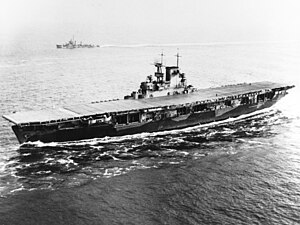
Back USS Wasp (CV-7) Afrikaans Уосп (CV-7) Bulgarian USS Wasp (CV-7) Czech USS Wasp (CV-7) German USS Wasp (CV-7) Spanish یواساس واسپ (سیوی-۷) Persian USS Wasp (CV-7) Finnish USS Wasp (CV-7) French USS Wasp (CV-7) Croatian USS Wasp (CV-7) Hungarian
 Wasp entering Hampton Roads
| |
| Class overview | |
|---|---|
| Name | Wasp class |
| Operators | |
| Preceded by | Yorktown class |
| Succeeded by | Essex class |
| Built | 1936–1940 |
| In commission | 1940–1942 |
| Planned | 1 |
| Completed | 1 |
| Lost | 1 |
| History | |
| Name | Wasp |
| Namesake | Wasp |
| Ordered | 19 September 1935 |
| Builder | Fore River Shipyard |
| Laid down | 1 April 1936 |
| Launched | 4 April 1939 |
| Sponsored by | Mrs. Charles Edison[1] |
| Commissioned | 25 April 1940 |
| Stricken | 15 September 1942 |
| Honors and awards | American Defense Service Medal ("A" device) / American Campaign Medal/European-African-Middle Eastern Campaign Medal (1 star) / Asiatic-Pacific Campaign Medal (1 star) / World War II Victory Medal |
| Fate | Scuttled after attack by the Japanese submarine I-19, 15 September 1942[2][a] |
| General characteristics (as built) | |
| Type | Aircraft carrier |
| Displacement | |
| Length |
|
| Beam |
|
| Draft | 20 ft (6.1 m) |
| Installed power |
|
| Propulsion | 2 × shafts; 2 × steam turbines |
| Speed | 29.5 knots (54.6 km/h; 33.9 mph) |
| Range | 12,000 nmi (22,000 km; 14,000 mi) at 15 knots (28 km/h; 17 mph) |
| Complement |
|
| Sensors and processing systems | CXAM-1 radar[3] |
| Armament |
|
| Armor |
|
| Aircraft carried | Up to 100 |
| Aviation facilities |
|
USS Wasp (CV-7) was a United States Navy aircraft carrier commissioned in 1940 and lost in action in 1942. She was the eighth ship named USS Wasp, and the sole ship of a class built to use up the remaining tonnage allowed to the U.S. for aircraft carriers under the treaties of the time. As a reduced-size version of the Yorktown-class aircraft carrier hull, Wasp was more vulnerable than other United States aircraft carriers available at the opening of hostilities. Wasp was initially employed in the Atlantic campaign, where Axis naval forces were perceived as less capable of inflicting decisive damage. After supporting the occupation of Iceland in 1941, Wasp joined the British Home Fleet in April 1942 and twice ferried British fighter aircraft to Malta.
Wasp was then transferred to the Pacific in June 1942 to replace losses at the battles of Coral Sea and Midway. After supporting the invasion of Guadalcanal, Wasp was hit by three torpedoes from Japanese submarine I-19 on 15 September 1942. The resulting damage set off several explosions, destroyed her water-mains and knocked out the ship's power. As a result, her damage-control teams were unable to contain the ensuing fires that blazed out of control. She was abandoned and scuttled by torpedoes fired from USS Lansdowne later that evening. Her wreck was found in early 2019.
- ^ Cressman, Robert J. (20 April 2018). "Wasp VIII (CV-7) 1940–1942". Dictionary of American Naval Fighting Ships. Naval History and Heritage Command. Retrieved 11 May 2013.
- ^ Evans, Japanese Navy, pp. 179–180; Hammel, Carrier Strike, pp. 24–41.
- ^ Macintyre, Donald, Capt. RN (Ret.) (September 1967). "Shipborne Radar". Proceedings. 93 (9/775). United States Naval Institute.
Cite error: There are <ref group=lower-alpha> tags or {{efn}} templates on this page, but the references will not show without a {{reflist|group=lower-alpha}} template or {{notelist}} template (see the help page).